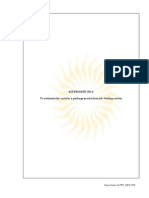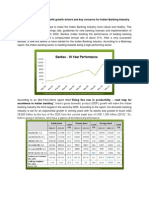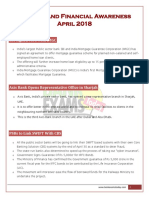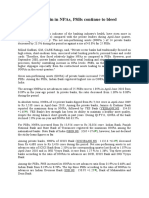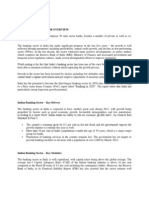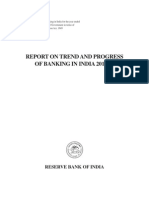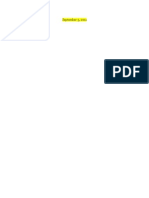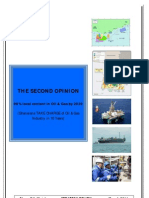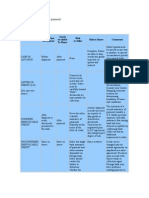Professional Documents
Culture Documents
General Banking News
General Banking News
Uploaded by
Shraddha GhagOriginal Description:
Copyright
Available Formats
Share this document
Did you find this document useful?
Is this content inappropriate?
Report this DocumentCopyright:
Available Formats
General Banking News
General Banking News
Uploaded by
Shraddha GhagCopyright:
Available Formats
Shadow banking in China http://www.thehindubusinessline.com/todays-paper/tp-opinion/article2586801.
ece Basically, this refers to non-depository banks and other financial entities such as investment banks, mutual funds, hedge funds, money market funds and insurers, who typically do not fall under banking regulation. RBI's most interesting move interest rate deregulation and its impacts http://www.thehindubusinessline.com/todays-paper/tp-opinion/article2595781.ece
Nod for Videocon, Liberty Mutual general insurance joint venture http://www.thehindubusinessline.com/todays-paper/tp-money-banking/article2595826.ece
FIIs allowed to invest in debt instruments of non-banking finance firms http://www.thehindubusinessline.com/todays-paper/tp-money-banking/article2595828.ece
New banks should be allowed to maintain competition, says Rangarajan http://www.thehindubusinessline.com/todays-paper/tp-others/tp-editorialfeature/article2601896.ece
Opportunity in private banking space growing' http://www.thehindubusinessline.com/todays-paper/tp-others/tp-editorialfeature/article2601893.ece
Focus on customers first, and not products As acquiring a new customer costs six times more than retaining a customer, banks also have the need to improve customer loyalty by segmenting them http://www.thehindubusinessline.com/todays-paper/tp-others/tp-editorialfeature/article2601903.ece
Deregulation of SB rates gives more options for customers' Deregulation of interest rates on savings bank account will only prompt customers to move from one bank to another, rather than bringing in new customers into the banking system, said Mr K.R. Kamath, Chairman and Managing Director, Punjab National Bank. People who do not have money in savings account of any bank might not even know what interest rates it offers. So it (the deregulation) will only benefit existing customers and prompt them to move from one bank to another for higher rates, Mr Kamath said at the Bancon here on Sunday.
Gokarn to banks: Use KYC to Grow with Your Customers Knowing customers will help banks to grow, said Dr Subir Gokarn, Deputy Governor, Reserve Bank of India, while delivering a special address at the Bancon 2011, held here on Saturday. If you really know your customer, you will be able to grow with your customers, he said, adding that knowledge capital will enable banks to move from KYC to GYC (grow with your customer). According to him, knowledge is the key to understanding the market. KYC norms will thus help banks understand the demographics, income, etc which banks could use favourably in serving customers better and thus grow with their customers. Dr Gokarn pointed out that it is the middle ground where there are many opportunities, and even as the banking system is dealing with its internal challenges, it is important for banks to come out with products and services targeting this opportunity. Just as there is an opportunity in rural financial inclusion, urban financial inclusion also throws open lot of opportunities for banks, said Dr Gokarn. Banks should analyse the basic motivating factors for savings and borrowings, which will help them meet the needs of customers better. Informal sector focus For all emergencies, the primary source of credit for the financially excluded in the rural and urban areas is the informal sector. Banks need to explore this opportunity and meet these needs, which mean lower cost of borrowings for these people, he said. Encashing the demographic dividend properly is not possible without knowing the customers better. Understanding the motivators for savings and borrowings is key to making financial inclusion a profitable venture. SBI chief for doing away with cash reserve ratio The Chairman of State Bank of India, Mr Pratip Chaudhuri, wants the cash reserve ratio (CRR) to be abolished. Today, banks are required to keep 6 per cent of their deposits in cash with the Reserve Bank of India, on which the RBI pays nothing. Speaking to Business Line on the sidelines of Bancon 2011, Mr Chaudhuri said that CRR is an NPA (non-performing asset) for banks.
Asked what according to him was the appropriate level of CRR, he said that he would like it to be brought to zero. I don't mind SLR, he said, referring to the 24 per cent statutory liquidity reserve to be maintained by banks, in liquid government bonds. SLR serves a purpose (of providing debt funds to the government), he observed. He also pointed out that the banks get reasonably good returns. Responding to another question, Mr Chaudhuri said that SBI had insured all of its export credit with the Export Credit Guarantee Corporation, as a result of which the bank's capital requirement would come down by 25 basis points. SBI is under pressure to keep pace with capital requirements. One of the means it has devised to achieve this is to insure export credit with ECGC, on account of which the capital call would come down. The bank believes that while the fee that it would pay ECGC would balance out the losses due to bad debts if the loans were not insured, the benefits would be mainly in terms of lower capital calls. Also, ECGC fees are fully tax-deductible. On the other hand, there is a cap (of 7.5 per cent of gross income) for loan loss provisions to count as tax deductible expenditure.
Is SBI's Tier-I capital really low? The downgrading of State Bank of India by Moody's, an international credit rating agency, is not because its Tier I capital is lower than the minimum stipulated by the RBI, but largely due to the Government of India (GoI) not fulfilling its own commitment. Recognising this, the government has recently decided to infuse Rs 8,500 crore in the form of capital, as reported recently in this paper. To state a fact, SBI's Tier I capital, at 7.6 per cent, is higher than the regulatory requirements, either in India or anywhere else on the globe. The important issues are discussed in this article. Regulations regarding the capital of commercial banks emanated from what are known as the Basel rules. These were laid down approximately two decades ago by the Bank for International Settlements (BIS), based in Basel. BIS is a club of the top central banks. Till then, there were no rules regarding the minimum level of capital of banks in relation to their assets (and consequently, borrowings through deposits or otherwise). When a new category, Tier II capital, was created, it consisted primarily of long-term loans that were contractually subordinated to deposits. The level was placed at 8 per cent as capital funds (CF), comprising Tier I (shareholders' funds) and Tier II. CAPITAL FUNDS The Reserve Bank of India adopted these rules in 1992. Later, the RBI tightened the level to 9 per cent of CF for banks operating in India, against the international norm of 8 per cent. The RBI further
laid down that banks should set apart from profits, 70 per cent of all Non-Performing Assets (NPAs), irrespective of the level of security held against them. Thus, if a loan is secured by valuable property worth more than 90 per cent (potential loss 10 per cent), even then, in the bank's books, it will be valued only at 30 per cent. Both these unique rules make the banks in India financially stronger than those in other countries. BIS modified the norms in 2006 (called Basel II), and the RBI has adopted them, with some changes, but retaining the higher level of 9 per cent for CF. Despite the prudential level of 8 per cent for CF, many large international banks in the West faced bankruptcy after 2008, because of a rule in the Basel norms. Chastened by the recent financial meltdown, all major central banks are in the process of evolving higher capital requirements and even some minimum liquidity to meet emergent circumstances. Only now, it is contemplated that there should be a minimum level of Tier I capital. The proposal is to have at least 4.5 per cent as Tier I capital, and an additional capital conservation buffer of 2.5 per cent, with a total of 7 per cent. It is yet to be implemented. SBI's Tier I capital is above this level also. Compared to SBI's level, the average of banks in Eurozone is 4.7 per cent, in UK 4.63 per cent, Japan 4.70 per cent and China 5.63 per cent; only in US, the average of major banks is 7.87 per cent, as per a study of top 1000 global banks. MINIMUM CAPITAL Even before BIS thought of minimum Tier I capital, the RBI had stipulated that banks in India should have Tier I capital equivalent to two-thirds of total capital funds, or 6 per cent. SBI's level is well above this limit. In spite of all these facts, Moody's latched on to the budget speech of the Union Finance Minister in 2010, when he said, inter alia, that: For the year 2010-11, I propose to provide a sum of Rs 16,500 crore to ensure that the public sector banks are able to attain a minimum 8 per cent Tier I capital by March 2011. For Finance Ministry babus, such commitments are not sacrosanct, and they weren't monitoring the situation vis--vis SBI. It is a different matter that, for them, even guarantees given by the Government are not binding and are rarely met on time and in full. To shore up capital in time, SBI has been pleading with the Government, in vain, to contribute its share. Taking cognisance of this, Moody's reportedly commented that SBI's efforts to secure this capital for the better part of the year demonstrates the bank's limited ability to manage its capital. SBI was, till recently, majority-owned by the RBI, and the Government took over the ownership a few years ago. Had the RBI continued to own, SBI might have raised the required capital well in time. Only now, Government mandarins have woken up and have promised to give additional capital of Rs 8,500 crore to SBI. With this, SBI should comfortably meet the Government's goal of 8 per cent Tier I capital, for public sector banks. To conclude, SBI continues to be a well-capitalised bank based on regulatory requirement, but needs to augment capital for expansion because the portfolio of non-performing assets of the banking system might grow due to recessionary conditions faced by the industry and business. And, government officials should take prompt action with regard to nationalised banks' capital needs, as they are the bedrock of our financial system.
SBI needs to augment capital for expansion as bank NPAs may grow as a result of the recessionary conditions. Planning Commission nod needed for capital infusion, says SBI chief The Planning Commission has to give its nod to the Central Government's Rs 3,000-4,000-crore capital infusion plan in State Bank of India, said the bank's chairman, Mr Pratip Chaudhuri. The Government has allocated us about Rs 3,000-4,000 crore. This has to go to the Planning Commission, because this is an investment, and not expenditure, decision. The Government will give capital to all the banks at the same time, Mr Chaudhuri told newspersons after a meeting between the Finance Minister and the heads of public sector banks here on Tuesday. The bank is hopeful of receiving capital by end-December. Capital infusion of Rs 3,000-4,000 crore coupled with reasonable profits will boost the bank's Tier I capital adequacy ratio to 9 per cent. In case we do not get funds by December, we should get them by March 2012, he said. The Government is mulling options such as preferential issue of shares, rights issue and qualified institutional placement for infusing funds into the bank. In case the Government decides to go for a rights issue or a QIP, then its stake will remain unaltered at 59.40 per cent, whereas if it is a preferential issue, the Government's shareholding could go up to 65 per cent, Mr Chaudhuri pointed out. Talking about asset quality, Mr Chaudhuri said that there has been a rise in non-performing assets in sectors such as power, aviation and textiles. Net Interest Margins State Bank expects to surpass its net interest margin target of 3.5 per cent during the current year. In the beginning of the year our projection was 3.5 per cent, and we have already achieved NIM of 3.62 per cent so far during this year. The current indication is that the margins will surpass that level by the end of this year, he said. The bank has no immediate plans to raise interest rates on saving deposits. We do not intend to raise interest rates now as there is no flight of deposits. On the contrary, we are seeing accretion in deposits, he said.
Moody's downgrades banks' outlook
Global credit rating agency Moody's Investors Service has revised its outlook for India's banking system to negative from stable. It also warned that bank ratings may come under downward pressure. This change in outlook is due to concerns that an increasingly challenging operating environment will adversely affect asset quality, capitalisation, and profitability of Indian banks. India's economic momentum is slowing because of high inflation, monetary tightening, and rapidly rising interest rates, said Mr Vineet Gupta, Vice-President and Senior Analyst, Moody's.
At the same time, Mr Gupta said, concerns have emerged over the sustainability of the recovery in the US and Europe, and the rise in the borrowing programme of the Indian Government, which could drain funds away from the private credit market. According to Mr Pratip Chaudhuri, Chairman, State Bank of India, the agency's earlier experience in overseas markets may have prompted it to believe the worst. Emphasising that the Indian banking system was stable, Mr Chaudhuri averred that unlike their counterparts in the West, Indian banks did not have any hidden assets, did not deal in exotic products and were conservatively leveraged. Mr Hemant Contractor, Managing Director, SBI, said the change in outlook by Moody's will not come in the way of his bank raising funds at competitive interest rates from overseas markets. Given the tightening environment, Moody's is anticipating that banks' asset quality will deteriorate over the next 12-18 months, thereby causing an increase in provisioning needs in 2012 and 2013. The rating agency expects loan growth to be a strain on the banks' capital over the next 12-18 months. As monetary conditions tighten and economic activities slow, it sees bank loan growth falling to 16-18 per cent in 2012 and 2013, from 21 per cent in 2011. Asset quality to deteriorate When it comes to profitability, Moody's expects it to come under pressure due to lower interest margins as deposit rates re-price and get a further push from the latest liberalisation on savings deposit rates. For those banks with weaker capital ratios and higher asset quality pressures, their standalone ratings are likely to come under pressure as underscored by Moody's downgrade of SBI's banking financial strength rating on October 4. Positive side But, on the positive side, Moody's recognised Indian banks' stable customer deposit base and high level of government securities holdings, which provide them with a resilient funding and liquidity profile that buffer them against destabilising shocks. Moody's also expects the Government to remain committed towards providing support to both public and private' banks. Such potential support translates to an average one-notch uplift to the banks' debt and deposit ratings to Baa2', compared with their standalone base line credit assessment of Baa3'
Where are India's savings? There are many paradoxes attached to Indian savings. At over 30 per cent, India has one of the highest savings/GDP ratios in the world. Yet, firms have been raising cheaper capital abroad, in the low-saving economies of the West. Small firms also find it difficult to finance their needs, while exclusion from the formal financial system is widespread.
What is equally paradoxical is that our policymakers point to the high domestic savings to also calculate a high potential growth rate. An incremental capital-output ratio of 4, with capital availability of 40 per cent of GDP (based on a peak savings achievement of 36 per cent plus a current account deficit of 4 per cent), gives a 10 per cent rate of growth. At the same time, despite these high savings, every effort is made to attract foreign capital. If it is domestic resources that is making growth possible, why is more foreign capital so essential? A figure of Rs 40 lakh crore is floated as required for infrastructure investment over the next five years. But since the safe level of the current account deficit is about 3 per cent of GDP, not more than onefourth of this can come from abroad. Foreign borrowing could be large in absolute numbers, but is dwarfed by the share of domestic resources required. What this means is that the Government should be spending most of its energy on improving the financial intermediation of domestic savings. SAVINGS INTERMEDIATION More household savings should pass through the formal financial sector. Financial inclusion can increase the share of financial savings. Large mobile penetration offers the opportunity to develop complementary institutions and finally achieve inclusion. But these opportunities are poorly utilised as yet. In the absence of financial inclusion, the government's large rural spend has actually reversed financial intermediation. The currency-deposit ratio, which had been steadily falling, increased over 2008-10, as more income went to people excluded from the banking system. After 20 years of financial reforms, the percentage of household financial savings in stocks and debentures, including through mutual funds, have shrunk from a pre-reform 20 per cent to as low as 5 per cent. Physical savings constitute half of domestic savings and the large household stocks of gold are not even part of measured physical savings. Intra-day trade and foreign portfolio flows dominate Indian equity markets. Allowing pension and insurance funds to invest in stocks could be one way of increasing household savings that are invested in markets. This type of savings also provides essential long-term finance for infrastructure. INSTITUTIONS AND SYSTEMS Technology cannot deliver alone. There have to be other institutions and systems to suit and adapt to Indian conditions. For example, deeper thought should be given to why the mutual fund model is not bringing in household savings. What is the proper role of brokers and of commission fees? Can competitive fees for genuine services be combined with tighter systems? One could probably increase the time for cheque clearance in relation to IPOs, thereby reducing households' need to authorise brokers, which can be misused. Information on low-cost financial alternatives such as index funds could be made available on websites. These websites on financial products can be ranked or rated by the Government or a rating agency.
The mobile equivalent of savings instruments, which works because it meets real needs, is yet to be developed. Households need secure inflation-indexed instruments that deliver decent returns. Despite rising interest rates, inflation gives households negative real interest rates on their savings. The private sector under-provides financial innovations, since copying reduces returns to the risks on costly product innovation and development. Households associate government securities (G-secs) with security. Government-led product innovation, more clearly linked to G-secs, may work. It is also the most stable way for the government to borrow. In Japan, government debt is domestically held unlike in Greece, where it is with foreign banks. UNDERDEVELOPED MARKETS The supply of G-secs is very large in India, but banks hold the bulk of this as a statutory requirement (SLR). Since it is not marked-to-market (MTM), interest rate risks are not hedged, preventing an active debt market from developing. It illustrates how a valid practice gets locked in, even when it has become dysfunctional. A system designed for one regime continues in another. In 1985, the Reserve Bank of India (RBI) provided for valuation of held-to-maturity securities at cost prices in order to facilitate movement to-market determined interest rates. This would mitigate the erosion in value of SLR G-secs from the expected rise in rates. But the system continues even in 2011, when two-way movement in interest rates is established. There is strong resistance from some banks to a fall in the MTM share of SLR securities. The absence of an active G-secs market also makes it difficult for the RBI to conduct Open Market Operations and fine-tune liquidity. As domestic savings do not enter and interest gaps widen in narrow markets, firms borrow abroad. India's short-term debt, as a proportion of its total external debt, has reached 40 per cent in terms of residual maturity, at a time when international markets are stressed. Despite India's high savings to GDP ratio, every effort is made to attract foreign capital. There is obviously a problem of financial intermediation of domestic savings. Asset quality continues to slip - SBI Even as the profit growth of State Bank of India (SBI) beat street estimates, asset quality worries continued to exert pressure on the bank's operating performance. In spite of showing a 12.3 per cent year-on-year growth in September quarter's net profit, higher slippages in non-performing assets (NPAs) led to the SBI stock losing 6.76 per cent in Wednesday's trade. NPA woes continue SBI's gross NPA grew 22 per cent between June 2011 and September 2011 as against 19 per cent by other public sector banks (PSBs). This even as SBI already has higher levels of stressed assets. Slippages have been witnessed predominantly in the agriculture, corporate (export oriented, iron and steel and hospitality segments) and SME portfolios.
Adding to concerns were slippages on assets already restructured earlier which contributed to 29 per cent of the net slippages between June and September. Consequently, SBI's gross NPA ratio rose from 3.28 per cent as of March 2011 to 4.19 per cent during the September 2011 quarter. Markets also seem concerned about expected moderation in economic growth exerting further pressure on the asset quality of banks, including SBI. Core operations improve The asset quality slippages overshadowed what was otherwise an encouraging performance as the bank increased its focus on profitability rather than volumes. While this led to loss of market share in loans, the bank's net interest income growth during the September quarter was at an impressive 28.6 per cent year-on-year compared to the 11 per cent registered by other PSBs and 18 per cent by private banks. SBI's net interest margin (NIM) improved from 3.43 per cent in the September 2010 quarter to 3.8 per cent in the latest reported quarter. The improvement in NIM is far better than that of other PSBs, thanks to re-pricing of high cost deposits raised in 2008 and retirement of bulk deposits. The significant proportion (47.6 per cent) of low-cost deposits also aided margins. Additionally, much of the hike in the bank's lending rates have been effected during the first half of this fiscal. Consequently, margins have also improved over the last two quarters. With the latest base rate hike coming in the second half of the September quarter, the benefits should be fully reflected in the December quarter. One more positive aspect of September quarter results was, despite the rise in NPAs, the bank managed to limit the rise of restructured assets (4.36 per cent of the total advances) which is among the lowest in the public sector bank space.
Misstep on small savings deregulation of savings bank account is bad Thrift has not been a rewarding proposition for Indian households in recent years, as interest rates on debt instruments have failed to keep up with runaway inflation. The post office-administered small savings schemes have been the worst placed in this regard, with their fixed interest rates not revised for years besides the cumbersome service procedures. No wonder, retail investors have been opting out of them to make a beeline for bank deposits or gold. Against this backdrop, one doubts whether the government's proposed measures to make these schemes more flexible and market-linked' will lure them back. It is now being sought to rationalise small savings products to conform to standard tenures ranging from one to 15 years. Their interest rates are to be reset annually and pegged to yields on comparable government securities, with mark-ups of 0.25 to one
percentage points. Long-term products will be made more liquid by offering early withdrawal options with penalty. If the formula being proposed were to be implemented, the rates on post office time deposits for 2011-12 would work out to 6.8-8 per cent for one to 5-year deposits. While an improvement over the existing rates, they are still way below the 8.50-9.50 per cent that banks are offering on their term deposits. Investors may additionally have to budget for lower rates next year, as we are probably now at the peak of the interest rate cycle. It is even worse in the long-term social security' schemes the Public Provident Fund (PPF), Senior Citizen's Savings Scheme and Monthly Income Scheme. The recommended rates of 8-9 per cent here are even lower than current rates and well below the 10 per cent-plus inflation levels. If shielding one's income from inflation is the primary concern for any long-term investor or senior citizen, these schemes will clearly not meet that objective. If unattractive interest rates do not turn off retail investors, the prospect of returns fluctuating from year to year surely will, as small savers build a corpus over many years. As the Government embarks on reforming small savings schemes, it should take note that most instruments that protect the small saver government pension payments, savings and bank deposits have already been thrown open to market forces and yet none of them have succeeded in consistently delivering inflation-beating returns. To genuinely protect small savers, what is needed really are bonds offering inflation-linked returns. If developed markets such as the US, which redirect retirement savings into equities, can provide inflation-protected bonds to savers, they surely deserve consideration in India. And there is no better vehicle for that than the ubiquitous post office. Home loans: Interest subsidy scheme extended to end-March 2012 The 1 per cent interest subvention scheme on housing loans up to Rs 10 lakh has been extended up to March 31, 2012, said a notification issued by the Reserve Bank of India on Wednesday. Loans sanctioned and disbursed between October 1, 2009 and March 31, 2011 are outside the ambit of the new liberalised scheme and they will be treated as per the old instructions (that is, loans up to Rs 10 lakh with project cost up to Rs 20 lakh), the RBI said. Banks may continue to claim reimbursement, at present, as per the original scheme. For claims in respect of the new scheme, revised instructions would follow, the RBI said. As per the revised scheme, the existing interest subvention of 1 per cent on housing loans was extended to housing loan up to Rs15 lakh, where the cost of the house does not exceed Rs 25 lakh. The ways of rating agencies opinion on Moodys downgrading SBI Rating agencies are known to move in sync, almost to the point of exhibiting herd behaviour. So, it is a little unusual to see the global top two Moody's and Standard & Poor's (S&P) taking diametrically opposite positions on the country's banking system, that too within a space of two days. On Thursday, Moody's downgraded its outlook for India's banks from stable' to negative', citing slowing economic momentum, high inflation and rising interest rates that could adversely affect (their) asset quality, capitalisation and profitability. The very next day saw S&P revise
upwards its rating of the Indian banking industry by a notch, while drawing attention to its high level of stable, core customer deposits, which limit dependence on external borrowings and also the Government's commitment to provide timely financial support. What does one make of these two divergent rating actions? The Government will, of course, feel vindicated by S&P's upgrade, which may even be claimed as righting' a wrong' committed by its rival. This is more so, given that Moody's had, earlier last month, also downgraded the financial strength rating of State Bank of India (SBI). Such righteous indignation, however, misses the real point. The banking system is only a mirror and barometer of the functioning of the larger economy, which includes the way in which it is being managed. There can be no two views today that growth in the economy has weakened, even while inflation remains stubbornly high. What is equally indisputable is that the second tenure of the ruling United Progressive Alliance has been marked by policy paralysis, and so-called governance deficit that has, in turn, dented investor confidence. If the real' economy isn't doing all that great, is it not bound to reflect in the financial system as well? After all, what does the increasing trend of delinquent loans to the power sector represent other than the fact that stalled tariff and distribution reforms have bankrupted state electricity boards, just as the indecision on coal linkages and land acquisition have held up projects? One way to look at the actions of rating agencies is to laugh at them. There is some justification for that: It, indeed, beats reason how Italy and Spain or, till four months back, even Portugal enjoy better ranking on these agencies' scale than India. But then, like it or not, the markets place great store on their opinion about the creditworthiness of a particularly country or company. And these opinions sometimes serve to bring the necessary market' pressure on recalcitrant governments. Take the example of SBI itself, where Moody's downgrade was based on the hazy picture with regard to capital infusion in the country's largest bank to enable it to meet regulatory requirements. This single rating action would probably be more effective in forcing a vacillating Government into doing something about it, than SBI's own Oliver Twist-like pleas and supplications. Moody's and S&P ratings matter not for what they are, but what they suggest about the real economy. ------------------------------------------------------------------------------------------------------------------------------Surge in bad loans in Sept quarter haunts public sector banks The bad loan problems of public sector banks have worsened significantly in the last three months, with manufacturing output slowing and interest rates rising further. Gross non-performing assets (NPAs) of these banks increased by 20 per cent between June and September 2011, the highest slippage in the last several years. The Rs 16,132-crore increase in NPAs in the latest quarter was more than the increase for the entire previous fiscal. Andhra Bank, State Bank of Hyderabad, State Bank of Bikaner and Oriental Bank of Commerce saw more than 50 per cent rise in NPAs over these three months. Loans are classified as NPAs when a part of principal or interest is due past 90 days. Computer-based identification of bad loans and restructured assets going bad escalated problems for public sector banks.
As a result, gross NPAs for state-owned banks rose from 2.45 per cent in June to 2.9 per cent by the September quarter. Private banks have managed much better with gross NPAs falling. Automatic recognition September 30, 2011 was the deadline for banks to shift to system-based identification of NPAs. Public sector banks made this shift recently. Computer-based NPA recognition removes the subjectivity that the banker may exercise in classifying a loan as non-performing. Smaller loan accounts, particularly agricultural loans, were the last to migrate to this system, and seem to have suffered the biggest slippage. Canara Bank, for instance, reported Rs 1,280 crore of additional NPAs, 33 per cent of the total because of such migration. Similarly, Union Bank of India witnessed a 20 per cent addition to NPAs from such accounts. Another reason for the rise in NPAs is the phenomenon of restructured loans going bad. Restructured assets refer to loans on which banks have allowed customers to postpone their interest payments until business prospects improve. Such restructured loans accounted for 4.4 per cent of the loans outstanding for the top nine state-owned banks. These banks accounted for over half of all loans advanced by the industry. The restructured loans that turned bad accounted for 17 per cent of all advances for these banks. The government-owned banks' net NPA ratio, after setting aside provisions, went up by nearly a third or Rs 12,000 crore. Due to these and other challenges, public sector banks saw a modest 5.4 per cent growth in profits in the September quarter. Private sector banks managed a 27 per cent growth. Finance Ministry asks Moody's to upgrade rating
Why private airlines deserve a bailout A leader of industry has recently said that in a market economy private players should not get any bailout in case they are in trouble. The airline industry is in trouble, indeed. Air India is continuously making huge losses, Kingfisher is almost at the verge of collapse, Jet has made huge losses, and Spice Jet, too. There is something wrong if an entire critical industry is in such deep trouble. This requires a policy response for industry, not mere rhetoric about capitalism and too from people, who in the not-sodistant past, asked for protection for Indian industry, and rightly too. FOREIGN AIRLINES PRIVILEGED The root of the current crisis lies in bad policy of the government. Our airlines are not allowed to fly overseas unless they have five years of operations.
Overseas airlines are freely allowed, within bilaterals, to fly to India. This shuts out lucrative routes for our airlines and allows overseas airlines to charge outrageous prices to Indian consumers. Bangalore is a classic example where overseas airlines are creaming the market. Our airlines compete in the domestic sector, which is extremely price-competitive without revenues from overseas sectors where they could earn more in their formative years. They are at a disadvantage. Our fuel cost is around 60 per cent of operational cost, an absurdly high percentage because of monopolistic conditions in the market place. The oil companies mercilessly jack up oil prices, charge much higher than international prices, collude together in pricing and suck the resources out of the airlines. The Competition Commission of India should suo motu conduct an enquiry into such predatory practices. This is compounded by very high taxes on airline fuel, levied by both the Centre and States. Each time prices are raised, both the Centre and the State earn more taxes, out of the misery of the industry. A case of exploitative suppliers and an insensitive government. THE AIR INDIA FACTOR But the biggest factor is the existence of a player who does not believe in rational pricing Air India. This airline is pricing below cost, to get market share and making huge losses. It is asking for a massive bailout from the government, using taxpayers' money. It is driving the private sector out of business, secure in the knowledge that it is a public sector undertaking and the government will bail it out using taxpayers' money. And worst of all, our government, our political leaders and industry leaders, believe this is alright and good policy but helping the industry as a whole through policy is an unnecessary bailout. This is absurd and distorts market pricing. No industry can compete and survive where one player makes huge losses, believes in predatory pricing and is bailed out continuously by the government. This is the key issue behind this crisis. If our industry leaders believe in the market economy they should ask for Air India to be allowed to shut down, not criticise private airlines' request for a bailout from bad policy. FUEL PRICING Our private airlines deserve a bailout. They are not failing because of mismanagement. Unfortunately, the debate is getting sidetracked because of the extravagant lifestyle of the owner of one airline. What needs to be done? First, we need competitive conditions in airline fuel pricing. The airline industry cannot subsidise losses made by the oil companies on diesel and kerosene pricing. The high margins on sales need to reduce and the monopoly broken in the public interest. The pricing has to be based on international prices without huge margins. The taxes levied by the Centre and the States need to be reduced to a reasonable level, and fixed on a base prices and not increased each time international prices go up.
Lastly, Air India cannot be subsidised by taxpayers and the private airlines asked to compete against the government with its vast resources. This is no competition at all, but hara kiri. If private airlines are to be allowed to fail, Air India should first be shut down. Let us remember that private airlines make up 80 per cent of India's capacity. Should 80 per cent suffer for the fallacy of 20 per cent? And if they shut down because of losses, what happens to the consumer, what happens to our economy if a very critical part of our infrastructure shut down due to bad policy? Helping the industry is not a bailout, but remedying bad policy they need urgent help. Customer service slips in public sector banks
Net interest margins must come down The RBI's Report on Trend and Progress of Banking in India 2010-11 notes that net interest margins (NIMs), a key measure of efficiency for banks, have to be reduced for more efficient financial intermediation. For this to happen, banks have to offer attractive interest rates to depositors and lower lending rates for borrowers. NIMs are the margins enjoyed by banks for doing their business and defined as interest earnings less interest expenses as a percentage of average total assets. NIMs for the Indian banking system have been between 2.5 per cent and 3.1 per cent. After seeing a declining trend for five years, NIMs once again moved up in 2010-11. NIMs in India are still high when compared to other emerging economies. If NIMs are reduced, it will help raise the level of domestic savings and channel them into investment and sustain high and inclusive growth, the report said. While profitability of banks is important, efficient financial intermediation is important from the point of view of economic growth. Increase other income' The report calls on banks to increase other income (this has declined over a decade when seen as a percentage of total assets) and reduce operating expenses (wages, transaction costs) to maintain profitability. Technological advancements have already helped reduce operating expenses. SBI, ICICI Bank lead peers in global branch network
You might also like
- Customer Request Form (CRF) PDFDocument1 pageCustomer Request Form (CRF) PDFMaurice Salinas100% (1)
- Regional Rural Banks of India: Evolution, Performance and ManagementFrom EverandRegional Rural Banks of India: Evolution, Performance and ManagementNo ratings yet
- Practical-3-Cost Estimate For Printed Job Using Gravure ProcessDocument5 pagesPractical-3-Cost Estimate For Printed Job Using Gravure ProcessShraddha Ghag100% (3)
- Practical-4-Cost Estimate For Printed CartonsDocument6 pagesPractical-4-Cost Estimate For Printed CartonsShraddha Ghag100% (1)
- IIBF Vision May 2011Document8 pagesIIBF Vision May 2011luvnuts4u luvnutsNo ratings yet
- Interest Rate Risk: Get QuoteDocument5 pagesInterest Rate Risk: Get Quoterini08No ratings yet
- Ruhi Agrawal Assignment (Banking)Document32 pagesRuhi Agrawal Assignment (Banking)Shraddha GawadeNo ratings yet
- 4163IIBF Vision March 2015Document8 pages4163IIBF Vision March 2015Madhumita PandeyNo ratings yet
- Banking AwarenessDocument6 pagesBanking AwarenessYashJainNo ratings yet
- 1939IIBF Vision April 2012Document8 pages1939IIBF Vision April 2012Shambhu KumarNo ratings yet
- GK Power Capsule NICL AO Assistant 2015Document45 pagesGK Power Capsule NICL AO Assistant 2015Abbie HudsonNo ratings yet
- P PP P PP GPPP: Key Points Financial Year '10 Prospects Sector Do's and Dont'sDocument7 pagesP PP P PP GPPP: Key Points Financial Year '10 Prospects Sector Do's and Dont'sTeja YellajosyulaNo ratings yet
- Centre Issues First Zero-Coupon Recap Bonds of 5,500 CR: P&SB To Park Investment in HTM Category Raises ConcernDocument16 pagesCentre Issues First Zero-Coupon Recap Bonds of 5,500 CR: P&SB To Park Investment in HTM Category Raises ConcernGopalakrishnan SivasamyNo ratings yet
- Use Unclaimed DepositsDocument5 pagesUse Unclaimed DepositsalkjghNo ratings yet
- L1 BankingDocument38 pagesL1 BankingdjroytatanNo ratings yet
- Industry Profile: Excellence in Indian Banking', India's Gross Domestic Product (GDP) Growth Will Make TheDocument27 pagesIndustry Profile: Excellence in Indian Banking', India's Gross Domestic Product (GDP) Growth Will Make TheNekta PinchaNo ratings yet
- GK Power Capsule For SBI Associate Assistant 2015Document56 pagesGK Power Capsule For SBI Associate Assistant 2015Nilay VatsNo ratings yet
- Banking Sector - Backing On Demographic DividendDocument13 pagesBanking Sector - Backing On Demographic DividendJanardhan Rao NeelamNo ratings yet
- Future of Indian Banking IndustryDocument8 pagesFuture of Indian Banking IndustrymbashriksNo ratings yet
- Asso PDFDocument54 pagesAsso PDFneeta chandNo ratings yet
- Minutes of Meeting On Response of Meeting Held On (22-4-17)Document4 pagesMinutes of Meeting On Response of Meeting Held On (22-4-17)Shivam KumarNo ratings yet
- Finance CompendiumDocument28 pagesFinance CompendiumNeelu AggrawalNo ratings yet
- Bhavesh Jhala 1 PDFDocument42 pagesBhavesh Jhala 1 PDFAniket AutkarNo ratings yet
- Further To The Above Developments, in July 2008, RBI Took Strict Measures To The Unsolicited Cards IssueDocument21 pagesFurther To The Above Developments, in July 2008, RBI Took Strict Measures To The Unsolicited Cards IssueGourav Kumar SwainNo ratings yet
- Here's Why We Need To Watch Closely The Effects of Demonetisation On The Banking SystemDocument4 pagesHere's Why We Need To Watch Closely The Effects of Demonetisation On The Banking SystemDILLIP KUMAR MAHAPATRANo ratings yet
- Budget and The Financial Sector Promises of Profound Changes in The FrameworkDocument4 pagesBudget and The Financial Sector Promises of Profound Changes in The Frameworkamli22No ratings yet
- Eco Final 3RD SemDocument10 pagesEco Final 3RD Semnagendra yanamalaNo ratings yet
- Balacesheet Analysis: Sbi Bank and Axis Bank: Vinay V. PatilDocument16 pagesBalacesheet Analysis: Sbi Bank and Axis Bank: Vinay V. PatilVinay PatilNo ratings yet
- April 2018 PDFDocument16 pagesApril 2018 PDFPallaviNo ratings yet
- Discuss The Recent Regulatory Changes Adopted For The Better Governance of Nbfcs in India. (Pradeeba C 215119061)Document5 pagesDiscuss The Recent Regulatory Changes Adopted For The Better Governance of Nbfcs in India. (Pradeeba C 215119061)Pradeeba ChinnaduraiNo ratings yet
- Gorakhpur InterviewDocument12 pagesGorakhpur InterviewRajesh VishwakarmaNo ratings yet
- The State Bank of IndiaDocument4 pagesThe State Bank of IndiaHimanshu JainNo ratings yet
- Banking Industry Full Overview ProjectDocument74 pagesBanking Industry Full Overview ProjectramansutharNo ratings yet
- Credit Appraisal Process PDFDocument93 pagesCredit Appraisal Process PDFPiyush Kulkarni80% (5)
- My Print ReportDocument51 pagesMy Print ReportrahulkatreNo ratings yet
- Banking Awareness Model Question Paper For IBPS PO and Clerks ExamsDocument19 pagesBanking Awareness Model Question Paper For IBPS PO and Clerks Examshackna100% (1)
- 6 Banking and Financial ServicesDocument5 pages6 Banking and Financial ServicesSatish MehtaNo ratings yet
- Now Get GK Updates, Quizzes and Notifications On MobileDocument27 pagesNow Get GK Updates, Quizzes and Notifications On MobilevanithasridaranNo ratings yet
- IIBF Vision February 2011Document8 pagesIIBF Vision February 2011Sushant MusaleNo ratings yet
- Economyria: Home Start Here Contact /suggest A Topic About UsDocument5 pagesEconomyria: Home Start Here Contact /suggest A Topic About Ustitiksha jewrajkaNo ratings yet
- GK Bullet - SBI PO (Mains) II PDFDocument33 pagesGK Bullet - SBI PO (Mains) II PDFgaurav singhNo ratings yet
- Weekly Economic Round Up 39Document14 pagesWeekly Economic Round Up 39Mana PlanetNo ratings yet
- Beepedia Monthly Current Affairs (Beepedia) October 2023Document121 pagesBeepedia Monthly Current Affairs (Beepedia) October 2023Vikram SharmaNo ratings yet
- "Credit Appraisal For Working Capital Finance To Small and Medium Enterprises at State Bank of IDocument93 pages"Credit Appraisal For Working Capital Finance To Small and Medium Enterprises at State Bank of Iverma_sk289% (9)
- KPMG ICC Indian Banking The Engine For Sustaining Indias Growth AgendaDocument52 pagesKPMG ICC Indian Banking The Engine For Sustaining Indias Growth AgendaNekta PinchaNo ratings yet
- Case Study GroupDocument9 pagesCase Study GroupPrabhujot SinghNo ratings yet
- Weekly Economic Round Up 40Document13 pagesWeekly Economic Round Up 40Mana PlanetNo ratings yet
- A Project On Sme Sector in India - Recent 9886649997Document72 pagesA Project On Sme Sector in India - Recent 9886649997Nadeem Naddu89% (9)
- Recent Devt BankingDocument29 pagesRecent Devt BankingshivaNo ratings yet
- Private Banks Rein in NPAsDocument8 pagesPrivate Banks Rein in NPAsanayatbakshNo ratings yet
- Mutual Funds: What Are Npas?Document6 pagesMutual Funds: What Are Npas?Nikhil VijayasenanNo ratings yet
- Beepedia Monthly Current Affairs (Beepedia) April 2023 PDFDocument134 pagesBeepedia Monthly Current Affairs (Beepedia) April 2023 PDFSAI CHARAN VNo ratings yet
- Answers To Some New Questions Asked in The BB & BSC Viva Boards in 2018-2019.pdf Version 1Document15 pagesAnswers To Some New Questions Asked in The BB & BSC Viva Boards in 2018-2019.pdf Version 1Tushar Mahmud SizanNo ratings yet
- Indian Banking SectorDocument4 pagesIndian Banking SectorAshok SharmaNo ratings yet
- Beepedia Monthly Current Affairs (Beepedia) December 2022Document116 pagesBeepedia Monthly Current Affairs (Beepedia) December 2022Sovan KumarNo ratings yet
- Banking Today Nov 15Document22 pagesBanking Today Nov 15Apurva JhaNo ratings yet
- (PSU / Private Banks) - in A Recent Interview, A Foreign Bank CEO Has Pointed OutDocument2 pages(PSU / Private Banks) - in A Recent Interview, A Foreign Bank CEO Has Pointed OutaravicampNo ratings yet
- Foreign Banks and GuidelinesDocument7 pagesForeign Banks and GuidelinesprasannarbNo ratings yet
- Central Bank of IndiaDocument5 pagesCentral Bank of IndiaTanya MendirattaNo ratings yet
- Banking India: Accepting Deposits for the Purpose of LendingFrom EverandBanking India: Accepting Deposits for the Purpose of LendingNo ratings yet
- T R A N S F O R M A T I O N: THREE DECADES OF INDIA’S FINANCIAL AND BANKING SECTOR REFORMS (1991–2021)From EverandT R A N S F O R M A T I O N: THREE DECADES OF INDIA’S FINANCIAL AND BANKING SECTOR REFORMS (1991–2021)No ratings yet
- Securitization in India: Managing Capital Constraints and Creating Liquidity to Fund Infrastructure AssetsFrom EverandSecuritization in India: Managing Capital Constraints and Creating Liquidity to Fund Infrastructure AssetsNo ratings yet
- Is 7028Document1 pageIs 7028Shraddha Ghag0% (1)
- Anderson Basicppt CH 06Document54 pagesAnderson Basicppt CH 06Shraddha GhagNo ratings yet
- WoodencontainersDocument70 pagesWoodencontainersShraddha GhagNo ratings yet
- b2b b2cDocument4 pagesb2b b2cShraddha GhagNo ratings yet
- 6.density & Colour MeasurementDocument3 pages6.density & Colour MeasurementShraddha GhagNo ratings yet
- Paper BoardsDocument16 pagesPaper BoardsAditi DesaiNo ratings yet
- Haz10 Spkr305A B ImContainersWorkshop Hand BillDocument55 pagesHaz10 Spkr305A B ImContainersWorkshop Hand BillShraddha GhagNo ratings yet
- Packaging MaterialsDocument15 pagesPackaging MaterialsShraddha Ghag100% (1)
- SssDocument36 pagesSssPavankocherlakota KocherlakotaNo ratings yet
- Debt Issue of Tata Coffee LTD: Mib AssignmentDocument2 pagesDebt Issue of Tata Coffee LTD: Mib AssignmentShraddha GhagNo ratings yet
- Word File For ObservationDocument1 pageWord File For ObservationShraddha GhagNo ratings yet
- Effective Time Management: Prof J Philip President XIMEDocument39 pagesEffective Time Management: Prof J Philip President XIMEShraddha GhagNo ratings yet
- Report On Trend and Progress of Banking in India 2010-11Document215 pagesReport On Trend and Progress of Banking in India 2010-11Shraddha GhagNo ratings yet
- Packaging Distribution &logistics (Sem VIII) : Assignment 1Document2 pagesPackaging Distribution &logistics (Sem VIII) : Assignment 1Shraddha GhagNo ratings yet
- Business LineDocument23 pagesBusiness LineShraddha GhagNo ratings yet
- Cbe News FinalDocument32 pagesCbe News FinalShraddha GhagNo ratings yet
- Gow Strategy Review March 2011Document15 pagesGow Strategy Review March 2011Shraddha GhagNo ratings yet
- Internship Report of Nepal BankDocument25 pagesInternship Report of Nepal Banksaajna gadal100% (1)
- Kaspersky Internet Security 2013: Reviewer's GuideDocument25 pagesKaspersky Internet Security 2013: Reviewer's GuideRahul GhoshNo ratings yet
- Master Circular KCCDocument16 pagesMaster Circular KCCVaibhav PandeyNo ratings yet
- Atria Convergence Technologies PVT - LTD, Due Date: 15/01/2017Document2 pagesAtria Convergence Technologies PVT - LTD, Due Date: 15/01/2017Vasav Panguluri100% (1)
- StatementArchive - 12 Sep 2023 2Document3 pagesStatementArchive - 12 Sep 2023 2Sriskanda SivapragasamNo ratings yet
- Audit of Cash Part 1Document38 pagesAudit of Cash Part 1Angel ModecioNo ratings yet
- Cash Poolg CMdfsDocument88 pagesCash Poolg CMdfsLaurentiu SavaNo ratings yet
- Methods of International PaymentDocument32 pagesMethods of International PaymentTHu TRan0% (1)
- Court of Appeals: DecisionDocument20 pagesCourt of Appeals: DecisionBrian del MundoNo ratings yet
- 8 - 8 - 31 - 2023 12 - 00 - 00 Am - 2023Document2 pages8 - 8 - 31 - 2023 12 - 00 - 00 Am - 2023Larry GatlinNo ratings yet
- Cardless Withdrawal Frequently Asked QuestionsDocument2 pagesCardless Withdrawal Frequently Asked QuestionsMichelle DimalantaNo ratings yet
- Po # 6380-Fans (SPF + Ef) Hvac-Al Saadeh Trading Est.Document3 pagesPo # 6380-Fans (SPF + Ef) Hvac-Al Saadeh Trading Est.Saleh El-hawaryNo ratings yet
- ToR - Exposure Visit Siinqee Bank Final 10.11.22Document4 pagesToR - Exposure Visit Siinqee Bank Final 10.11.22Wg Iddeessa100% (1)
- TD-5580 (Us)Document1 pageTD-5580 (Us)hkm_gmat4849No ratings yet
- Effects of ""Susu"" - A Traditional Micro-Finance Mechanism On Organized and Unorganized Micro and Small Enterprises (Mses) in GhanaDocument8 pagesEffects of ""Susu"" - A Traditional Micro-Finance Mechanism On Organized and Unorganized Micro and Small Enterprises (Mses) in GhanaMoses DumayiriNo ratings yet
- Mortgage 101Document2 pagesMortgage 101Mathew Ray PerezNo ratings yet
- Bill Distributor-Fesco Application FormDocument3 pagesBill Distributor-Fesco Application FormMughal Raza GNo ratings yet
- Chapter 19 (Saunders)Document17 pagesChapter 19 (Saunders)sdgdfs sdfsfNo ratings yet
- Chalan Form 1Document1 pageChalan Form 1Ajmal FarooqNo ratings yet
- Wipro OpeningsDocument2 pagesWipro Openingswebsite creatorNo ratings yet
- BRO IMP QPDocument3 pagesBRO IMP QPshashank reddyNo ratings yet
- Competence Application Standards 1718Document6 pagesCompetence Application Standards 1718Robert FordNo ratings yet
- InterfazPlatino-Version 1 41Document91 pagesInterfazPlatino-Version 1 41sadoly7224No ratings yet
- Mid Term Accounts - SubjectiveDocument4 pagesMid Term Accounts - Subjectivekarishma prabagaranNo ratings yet
- Bandhan Bank MbaDocument15 pagesBandhan Bank MbaAmanNandaNo ratings yet
- Journal EntryDocument8 pagesJournal Entryapi-417927166No ratings yet
- A Study On E-WalletDocument4 pagesA Study On E-WalletEditor IJTSRDNo ratings yet
- ICICI Amazon Nov 19Document3 pagesICICI Amazon Nov 19Mahesh Kumar K BNo ratings yet
- How To Avail Bank of Baroda Mobile Banking (M-CONNECT+) : A. Submit A Simple Form To Your Base BranchDocument5 pagesHow To Avail Bank of Baroda Mobile Banking (M-CONNECT+) : A. Submit A Simple Form To Your Base BranchDev SaraswatNo ratings yet



